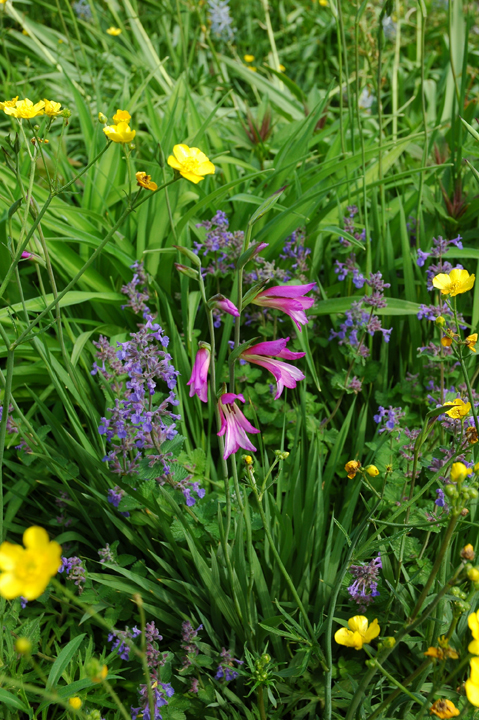...some species are hardy!
Store them cool but not freezing over winter, or choose hardy species.
I heard you talk and wrote a summary for annarbor.com to share a few tips that stood out
for me in your talk.
One of the tips was about burying cannas and dahlias 18"
to keep them over winter-- this is such an awesome tip because I
have nice soil in my veggie bed doing NOTHING over winter, when it
could be storing these semi-hardy tubers/bulbs!
I know you said elephant ears would have to go down
deeper to at least 24", but what about glads? Could they be OK at
18"? - Monica Milla -
Thanks for letting people know about us, Monica!
This winter, if this warmth continues, cannas may make it
through to spring without any protection at all in our
portion of "zone 5." Gladiolas are not quite so tough (most
Gladiolus species are zone 9) yet we've seen them pull
through a few special winters in special places, too.
Could the glads make it through a normal zone 5 winter (down to
-20°F) if buried 18" deep? Probably. However, we've only ever put
Gladiolus bulbs into deeper pits -- we had a pit dug for
other things and so stashed all our special things there. We
haven't tried them in shallower storage. However, we think they
would survive with 18" of Mother Earth as insulation.
There's more about burying tender perennial roots as a winter
storage method in Ensemble Weekly Editions
What's
Coming Up #7 and
What's
Coming Up #160
Hardy glads
hardly the same as their big cousins
Most of the 180 species of Gladiolus, including all of
those used to develop the very popular cut flower hybrids, are
native to frost free parts of Africa (especially South Africa),
Arabia and Madagascar. That's zone 9 and 10. A few that come from
Europe and the Mediterranean can tolerate some cold if the drainage
is very good.
Zone 6 species: G. byzantinus (also known as G.
communis ssp. byzantinus)*,G. illyricus, G.
imbricatus, G. italicus.
Zone 7: G. tristis, G. atroviolaceus
Zone 8: G. papilio, G. cruentus, G. x
colvillei, G. saundersii

Gladiolus byzantinus have been resident in our
well-drained zone 5 gardens for 20 years. Above, it is in bloom
with catmint (Nepeta x mussinnii) and swamp buttercup
(Ranunculus acris) in spring. They're interesting but not
the show-stoppers their big hybrid cousins are. In addition, G.
byzantinus multiplies like grass and have to be thinned every
year or they plants quickly become too crowded to bloom well.